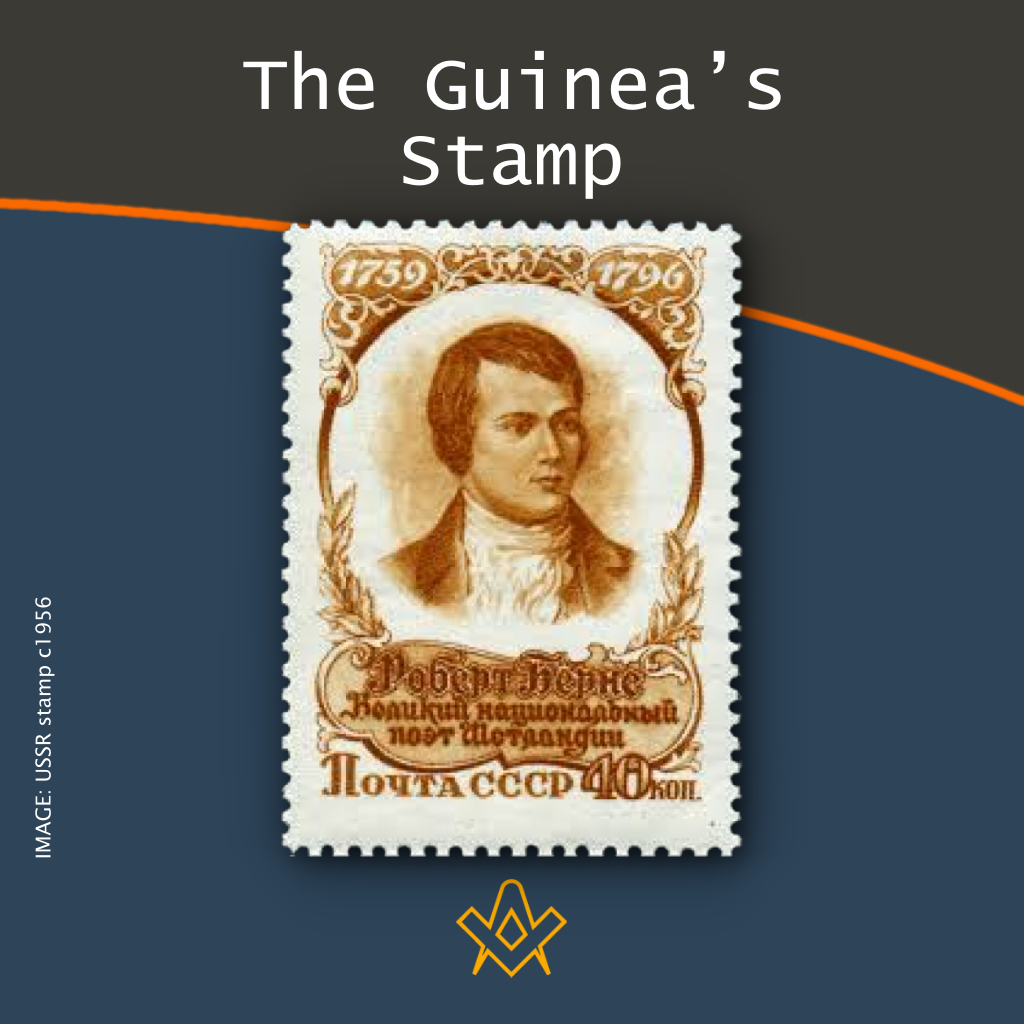That rank is but the guinea’s stamp, the man himself’s the gold.
But what does this mean, even given the lyric and tone of Burns’ time? It is oft times used in a derogatory sense, (somewhat in good humour) between Masons (or not) on the achieving of honours.
But its antecedents are much more complex than that. Note the Final Charge, sometimes said by a Junior Warden when closing the lodge in the second degree.
![]()
happy we have met,
happy we have been,
happily we part and
happy to meet again…
It would appear that the origin of the verse was mid nineteenth century and is used in some lodge’s festive boards as a Tyler’s final toast (before or part of):
Dear Brethren of the mystic tie the night is waning fast. Our duties done, our feast is o’er, this song must be the last. Goodnight, goodnight once more, once more repeat the farewell strain. Happy to meet, sorry to part, happy to meet again.
This stanza is in fact the last verse of a six-verse poem, entitled “The Final Toast”. It is not commonly known that there is more than one verse and very few would be able to recite the entire poem.
The poem has been used in various countries from time to time, but its earliest printing was in the “Masonic Vocal Manual” published at Hebden Bridge, Yorkshire, in July 1852.
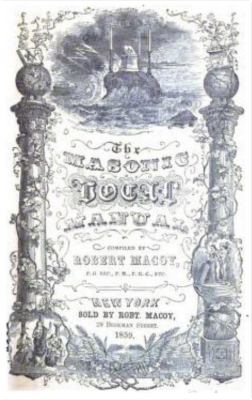
“The Masonic Vocal Manual” – this version published by Robert Macoy, New York, 1859
A number of different versions have been printed over the years, but the original (slightly edited) reads as follows:
Are your glasses charged in the West and South?
The Worshipful Master cries;
They’re charged in the West, They’re charged in the South,
Are the Wardens’ prompt replies;
Then to our final toast to-night your glasses fairly drain
Happy to meet, sorry to part, happy to meet again
Oh! Happy to meet again!
The Masons’ social brotherhood around the festive board,
Reveals a wealth more precious far than selfish miser’s hoard
They freely share the priceless stores that generous hearts contain
Happy to meet, sorry to part, happy to meet again!
We work like masons free and true, and when our task is done,
A merry song and cheering glass are not unduly won;
And only at our farewell pledge is pleasure touched with pain
Happy to meet, sorry to part, happy to meet again!
Amidst our mirth we drink “To all poor Masons o’er all the world”
On every shore our flag of love is gloriously unfurled,
We prize each brother, fair or dark, who bears no moral stain
Happy to meet, sorry to part, happy to meet again!
The Mason feels the noble truth the Scottish peasant told
That rank is but the guinea’s stamp, the man himself ’s the gold
With us the rich and poor unite and equal rights maintain
Happy to meet, sorry to part, happy to meet again! etc
The author of the poem has from time to time been said to be Rudyard Kipling or even Robbie Burns, both well-known and dedicated Freemasons.
Whilst there are certain lines that may be classic Burns (i.e., the reference to the Scottish peasant or the phrase, “the mystic tie”), or the fact that it was written in India where Kipling spent most of his life, the final toast was written by a Freemason, Bro David Lester Richardson.
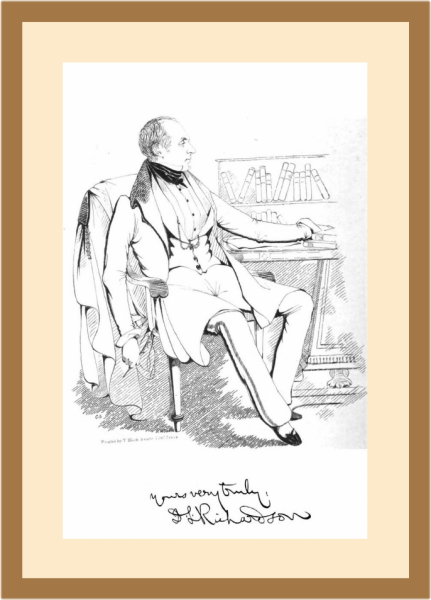
David Lester Richardson, Calcutta Monthly Journal and General Register of Occurrences …for the Year 1838 By Colesworthey Grant
Richardson was born in London on 22 January 1801, the son of Lieutenant Colonel David Thomas Richardson.
Bro Richardson was initiated into the Lodge of Industry and Perseverance No. 126, Calcutta, (now No. 109 meeting in London) and although it appears he never took office he was obviously a regular attendee and partaker of much of the spirit within Freemasonry to have written such an ode
Whilst in Calcutta, Richardson met another Freemason, Professor William Henry Hammerton, born of Irish Parentage, in Nottingham, England in 1795.
Hammerton was initiated into the Aurora Lodge of Candour and Cordiality No. 816 in Calcutta, and eventually, in 1841, joined Richardson’s lodge, No. 126.
This meeting led to “The Final Toast” being put to music during the 1840s, with both artists complementing each other’s skills.
Masons are aware that Robert Burns was a Freemason. He remained so all of his adult life and was Senior Warden of Lodge St Andrew, Dumfries, (dormant) when he died.
One of his most famous poems: “A Man’s a Man for a’ That“, was sung at the official opening of the new Scottish parliament. Freemasons, especially Scottish Freemasons, all over the world are intensely proud that a Masonic Anthem was chosen to mark this historic occasion.
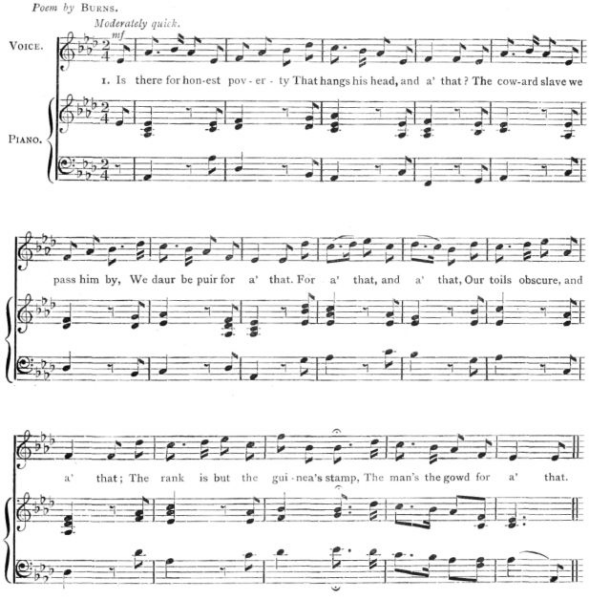
Is there for honest poverty
That hings his head, an’ a’ that? The coward slave, we pass him by –
We dare be poor for a’ that!
For a’ that, an’ a’ that,
Our toils obscure, an’ a’ that,
The rank is but the guinea’s stamp, The man’s the gowd for a’ that.
In dissecting this line what is found is that ‘rank’ is a reference to ‘poor’ metal, or at least a less valuable metal that is needed to make a pressing stamp for the production of coinage. Naturally it would be an inferior metal but of harder substance (as gold is quite soft) for the purpose.
Therefore, the concept of rank (metal tool) being the means of stamping a gold coin obviously related to man in his development and therefore whatever a man is ‘stamped’ with he himself has the possibility, nay, the inner ability to be ‘gold’. Gold, esoterically referring to a man’s soul and certainly strength of character.
The natural conclusion for Freemasons is the benefit of learning through allegory and ritual, to achieve a better life and moral worthiness to their fellow man.
Video: A Man’s a Man for A’ That Rabbie Burns. (3 mins)
Article by: Paul Gardner

Paul was Initiated into the Vale of Beck Lodge No 6283 (UGLE) in the Province of West Kent, England serving virtually continuously in Office and occupying the WM Chair on three occasions.
Paul joined Stability Lodge No 217 in 1997 (UGLE) and now resides with Kent Lodge No 15, (UGLE) the oldest Atholl Lodge with continuous working since 1752, where he was Secretary and now Assistant Secretary and archivist, having been WM in 2002.
In Holy Royal Arch he is active in No 15 Chapter and Treasurer of No 1601, which was the first UGLE Universities Scheme Chapter in 2015.
He was Secretary of the Association of Atholl Lodges which maintains the heritage of the remaining 124 lodges holding ‘Antients’ Warrants and has written a book on Laurence Dermott. - https://antients.org
Recent Articles: by Paul Gardner
 Unearth the mystic origins of Freemasonry in 'That He May Be Crafted.' Paul Gardner explores the symbolic use of working tools from the earliest days of this secret society, revealing a time when only two degrees existed. Delve into this fascinating study of historical rituals and their modern relevance. |
 Paul Gardner looks to a time when politics and Masonry were not precluded, but shush! This was London Masons and the Spitalfields Act of 1773-1865. |
 That rank is but the guinea’s stamp, the man himself’s the gold. But what does this mean, even given the lyric and tone of Burns’ time? It is oft times used in a derogatory sense, (somewhat in good humour) between Masons (or not) on the achieving of honours. But its antecedents are much more complex than that. |
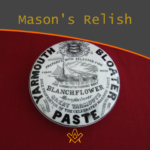 John and Timothy Coleman Blanchflower were initiated in Walpole Lodge, No. 1500, Norwich England on 2 December 1875; noted as a purveyor of ‘sauce’ to masons! |
 Jacob’s Ladder occupies a conspicuous place among the symbols of Freemasonry being on the First Degree Tracing Board, the most conspicuous and first seen by the candidate on his initiation – a vision of beauty and intrigue for the newly admitted. |
 During a detective hunt for the owner of a Masonic jewel, Paul Gardner discovered the extraordinary life of a true eccentric: Dr William Price, a Son of Wales, and a pioneer of cremation in Great Britain. Article by Paul Gardner |
 Paul Gardner tells the story of his transition from one rule book to another – from the Book of Constitutions to the Rule Book for Snooker! |
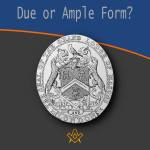 Due or Ample Form? What is ‘Ample’ form, when in lodges the term ‘Due’ form is used? |
 The Butcher, the Baker, the Candlestick Maker Paul Gardner explores the Masonic link between provincial towns’ craftsmen, shop keepers and traders in times past. Many remain in the modern era and are still to be found on the high street. |
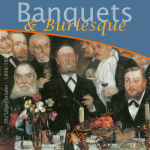 Masonic dining and banquets, at least for the annual Investitures, were lavish, and Kent Lodge No. 15, the oldest Atholl lodge with continuous working from 1752, was no exception. |
 The ‘cable-tow’ or ‘noose’ is used in Craft Masonry as part of the ritual, as are ropes and ties in other degrees - but what does it symbolise? |
 Paul Gardner reflects on those days of yore and the “gentleman footballer” in Masonry |
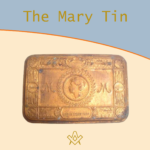 What is the Masonic connection with the 1914 Christmas Mary Tin |
 That Takes the Biscuit - The Patriot Garibaldi Giuseppe Garibaldi Italian general and politician Freemason and the Grand Master of the Grand Orient of Italy. |
 W.Bro. Paul Gardner looks at a mid 19th century artefact and ponders ‘Chairing’ |
masonic knowledge
to be a better citizen of the world
share the square with two brothers

click image to open email app on mobile device



